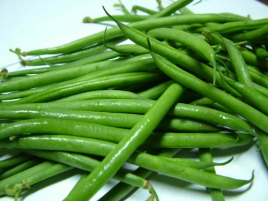The Best Foods To Eat For Type-2 Diabetes
By Aurora Geib | May 18, 2012

Getting diagnosed with type-2 diabetes can do a lot of things to your perspective: Your life, your priorities, your family and even your food. “What am I supposed to eat now?” is a common question after the initial prognosis. Fortunately, enjoying food may still be possible. Diabetes educator, Kathy Honick, of the Barnes Jewish Hospital at St. Louis suggest that patients newly diagnosed with diabetes ask a dietitian to learn what foods may now be available for them and what to avoid.
Type-2 diabetics: Why you want to watch your diet
A diet of sugary drinks and highly processed food is an abnormal dietary intake that causes the increasing and prolonging of blood glucose after eating. This condition forces the pancreas to produce more insulin, the key factor responsible for the diabetes affecting more or less 25.8 million Americans of all ages.
For the type-2 diabetic, the body no longer has enough insulin to keep blood glucose level normal. The body acquires an insulin resistance, thus preventing it from being able to use blood glucose for energy. When this occurs, sugar levels in the body shoot up causing hyperglycemia. Common symptoms include frequent urination, fatigue and hunger. This condition builds up over time and normally affects people who are overweight, although it has been also known to happen to people who are thin. It is also commonly found in the elderly.
An unmanaged diabetes condition can cause serious complications such as kidney problems, nerve damage, high blood pressure and heart attack. The skin can develop sores and infections especially at the feet, sometimes times leading to amputation.
The Glycemic Index
Blood glucose levels are affected by the kind food taken. Food having the greatest effect is carbohydrates because they are processed into glucose from the intestine and into the blood. All carbohydrates, however, are not equally created. Some can be digested at different levels and produce varying effects in raising the glucose level after a meal.
This effect has been quantified by the Glycemic Index. According to the University of Sydney website, food with high GI are those rapidly digested and absorbed resulting to a marked fluctuation in blood sugar levels. The foods with low GI, on the other hand, are slowly digested and absorbed, producing a slow and gradual rise in blood sugar and insulin levels. Studies have shown that a low GI diet improves both glucose and lipid profiles in people with diabetes since the diet also reduces insulin levels and insulin resistance. It also has the added benefit of weight control since it helps control appetite and delays hunger.
The World Health Organization (WHO) and the Food Agriculture Organization (FAO) in 1999 recommended to people of industrialized countries to base their diets on low GI food to prevent the diseases of affluence like diabetes, obesity and coronary disease.
Best foods for type-2 diabetics
People diagnosed with diabetes, according to the American Diabetes Association, should take steps to control their blood sugar. However, this does not mean that their diet is vastly different from the general population. The main emphasis is losing weight and eating right. Below are some foods that can help in weight management and the prevention dangerous spikes in blood glucose:
1. Choose complex carbohydrates over simple carbohydrates – Keeping sugar levels stable is a top priority for diabetics. That is why complex carbohydrates are a better source of energy compared to simple carbohydrates that produce spikes in the bloodstream and cause serious problems. Try to avoid sweet drinks, cakes, candies or at the very least try to take them in very small quantities. Instead, choose complex carbohydrates like whole wheat, brown rice, beans, oats, quinoa and whole wheat pasta as they are slowly digested and absorbed into the blood, thus producing a gradual and consistent sugar level instead of unpredictable spikes.
2. Increase the amount of fiber you eat – Fiber is a type of carbohydrate; however, it is not broken down by the body and does not contribute any calories. Fiber has two kinds: soluble and insoluble. Insoluble fiber keeps the digestive tract working (i.e. whole wheat bran) while soluble fiber can lower cholesterol. The New England Journal of Medicine featured a study where diabetics more or less consumed 50 grams of soluble fiber daily. The study indicated that those who had more fiber were able to control their blood glucose much better than those who didn’t. An example of this type of fiber is oatmeal. Moreover, fiber adds bulk to what you eat, helping you manage your appetite and keeps those calories in check. Fruits and vegetables are a good source of this nutrient.
Learn more: http://www.naturalnews.com/035892_type-2_diabetes_foods_glycemic_index.html#ixzz1vCj5bzDD















